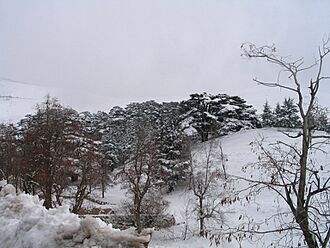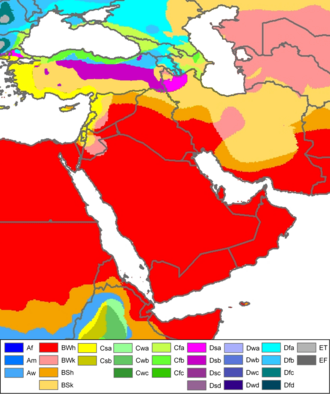West Asia facts for kids
 |
|
| Area | 5,994,935 km2 (2,314,657 sq mi)a |
|---|---|
| Population | 313,450,000 (2018) (9th) |
| Population density | 50.1/km2 (130/sq mi) |
| GDP (nominal) | $3.383 trillion (2019) |
| GDP (PPP) | $9.063 trillion (2019) |
| GDP per capita | $10,793 (2019; nominal) $28,918 (2019; PPP) |
| HDI | |
| Ethnic groups | Semitic, Turkic, Iranic, Armenian, North Caucasian, Georgians, Hellenic, Indo-Aryan, etc. |
| Religions | Islam, Christianity, Judaism, Baháʼí, Druzism, Yarsanism, Yazidism, Zoroastrianism, Mandaeism, Hinduism, Buddhism, etc. |
| Demonym | West Asian Western Asian |
| Countries |
20 recognized
3 unrecognized
|
| Dependencies | |
| Languages |
Official languages
Other languages
Afroasiatic:
Austronesian: Indo-European: NE Caucasian: NW Caucasian:
Turkic:
|
| Time zones | |
| Internet TLD | .ae, .am, .az, .bh, .cy, .eg, .ge, .il, .iq, .ir, .jo, .kw, .lb, .om, .ps, .qa, .sa, .sy, .tr, .ye |
| Calling code | Zone 9 except Armenia, Cyprus (Zone 3) & Sinai (Zone 2) |
| Largest cities | |
| UN M49 code | 145 – West Asia142 – Asia001 – World |
|
a Area and population figures include the Sinai
b Among the top 100 urban areas of the world by population
|
|
West Asia, also called Western Asia, is the part of Asia that is furthest to the west. It includes areas like Anatolia (most of Turkey), the Arabian Peninsula, Iran, Mesopotamia (modern-day Iraq), the Armenian highlands, the Levant (countries like Lebanon and Syria), the island of Cyprus, and the Sinai Peninsula in Egypt.
This region is separated from Africa by a narrow strip of land called the Isthmus of Suez in Egypt. It is separated from Europe by the Turkish Straits and the Greater Caucasus mountains. To its northeast is Central Asia, and to its east is South Asia.
Many seas surround West Asia, including the Aegean Sea, Black Sea, Caspian Sea, Persian Gulf, Arabian Sea, Red Sea, and Mediterranean Sea. West Asia covers a large area of about 5.9 million square kilometers (2.3 million square miles) and has a population of around 313 million people.
Contents
Understanding West Asia
The name "West Asia" is used to describe this geographical area. It is different from the term "Middle East", which is more about politics and has changed over time. West Asia focuses on the actual land and its features.
Many countries are part of West Asia. Some of the most populated ones are Iran, Turkey, Iraq, Saudi Arabia, and Yemen. Thirteen of the 20 countries in this region are part of the Arab world.
History of the Region
People started using the term "Western Asia" a long time ago, even before "Near East" became a common political term. In ancient times, it meant the part of Asia that was known to classical writers. This was different from "interior Asia" (like Scythia) and "Eastern Asia" (like India).
In the 20th century, "Western Asia" was used in archaeology and ancient history. It often referred to the "Fertile Crescent" (a crescent-shaped region of fertile land) without including Ancient Egypt. This helped compare early civilizations.
Geography and Land
West Asia is surrounded by eight major seas. These include the Aegean Sea, Black Sea, Caspian Sea, Persian Gulf, Arabian Sea, Gulf of Aden, Red Sea, and Mediterranean Sea.
To the north and northwest, the Turkish Straits and the Greater Caucasus mountains separate it from Europe. To the southwest, the Isthmus of Suez separates it from Africa. To the northeast and east, it borders Central Asia and South Asia.
Land Features
West Asia has many mountains. The Anatolian Plateau in Turkey is located between the Pontus Mountains and Taurus Mountains. Mount Ararat in Turkey is very tall, reaching 5,137 meters (16,854 feet). The Zagros Mountains are found in Iran, near its border with Iraq.
In Yemen, many areas are higher than 3,700 meters (12,100 feet). The Dead Sea, located between the West Bank, Israel, and Jordan, is the lowest point on Earth's surface, at 418 meters (1,371 feet) below sea level.
The Rub' al Khali desert, one of the world's largest sand deserts, covers the southern part of the Arabian Peninsula. This includes parts of Saudi Arabia, Oman, the United Arab Emirates, and Yemen.
Climate and Water


Most of West Asia has a dry or semi-dry climate. It can experience droughts, but it also has large forests and fertile valleys. The region has grasslands, rangelands, deserts, and mountains.
Getting enough water is a big challenge in many parts of West Asia. The population is growing fast, which means more demand for water. Also, saltiness and pollution threaten water supplies. Important rivers like the Tigris and Euphrates provide water for farming.
Two main winds affect West Asia: the sharqi and the shamal. The sharqi is a dry, dusty wind from the south and southeast. It can cause strong sandstorms. The shamal is a summer wind from the northwest that blows over Iraq and the Persian Gulf countries.
People and Languages
The population of West Asia was about 272 million in 2008 and is expected to reach 370 million by 2030. This means the population is growing quite fast.
The largest groups of people in West Asia are Arab, Persian, and Turkish. The main languages spoken are Arabic, Persian, and Turkish. Each of these languages has about 70 million speakers. Other important languages include Kurdish, Azerbaijani, Hebrew, and Armenian.
Religions of West Asia
Religion in West Asia (2020) Islam (92.59%) Christianity (3.87%) Judaism (2.02%) No religion (1.16%) Hinduism (0.32%) Other religions (0.25%) Buddhism (0.15%) Folk religions (0.06%)
West Asia is a very important region for religions. Four major religions started here: Islam, Christianity, Judaism, and the Druze faith.
Islam is the largest religion in West Asia. However, Judaism and Christianity are also very common. In countries like Armenia and Georgia, different types of Christianity are the main religions. There are also old Christian communities in countries like Lebanon, Iraq, Iran, Turkey, Syria, Jordan, Israel, and Palestine. Many foreign workers in the Arabian Peninsula are also Christian.
Judaism is the main religion in Israel. There are also small, old Jewish communities in countries like Turkey, Azerbaijan, and Iran.
The Druze faith also began in West Asia. It is a religion based on the teachings of certain figures and Greek philosophers. Most Druze people live in Syria, Lebanon, and Israel.
Other important minority religions in the region include the Baháʼí Faith, Yarsanism, Yazidism, Zoroastrianism, and Mandaeism.
Economy and Resources
The economy of West Asia is varied and growing quickly. Turkey has the biggest economy in the region, followed by Saudi Arabia and Iran.
The most important industry in West Asia is oil. More than half of the world's oil reserves and about 40 percent of the world's natural gas reserves are found here. This makes the region very important for global energy.
Sports in West Asia
Sports are popular in West Asia, with several organizations and events:
- The West Asian Tennis Federation organizes tennis championships.
- The West Asian Billiards & Snooker Federation organizes billiards and snooker tournaments.
- The West Asian Games are a multi-sport event where athletes from 13 countries compete. They have been held in 1997, 2002, and 2005.
- The West Asian Football Federation was created in 2001 and organizes the WAFF Championship for football.
- The West Asia Basketball Association organizes the WABA Championship for basketball.
Images for kids
-
Monastery of Saint Anthony of Qozhaya in Lebanon.
-
Jews praying at the Western Wall.
See also
 In Spanish: Asia Occidental para niños
In Spanish: Asia Occidental para niños
- Middle East
- Cinema of West Asia
- List of World Heritage Sites in Western Asia
- West Asian Games
- West Asian Basketball League
- West Asia Basketball Association
- West Asian Billiards & Snooker Federation
- West Asian Tennis Federation
- West Asian Football Federation







